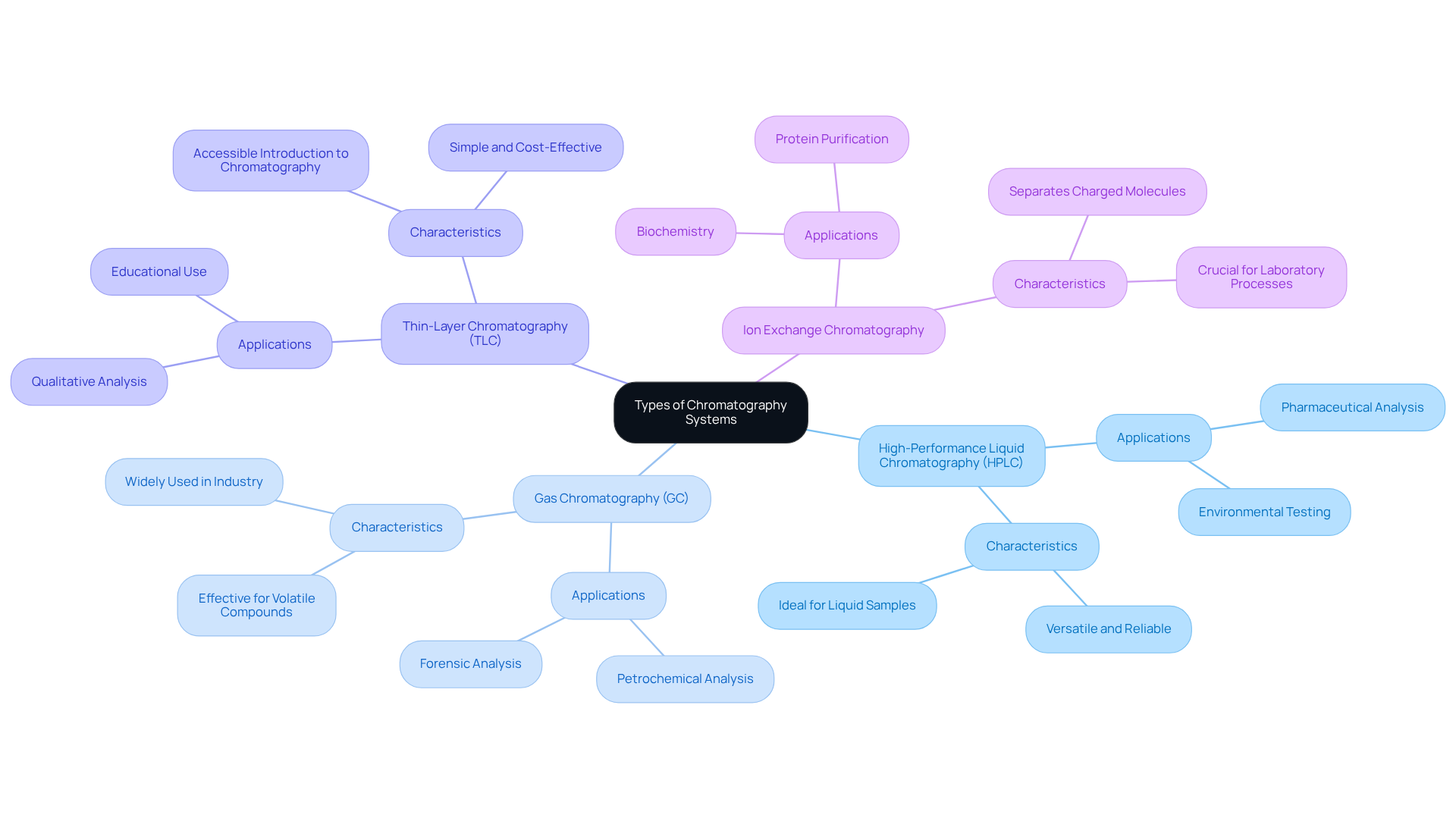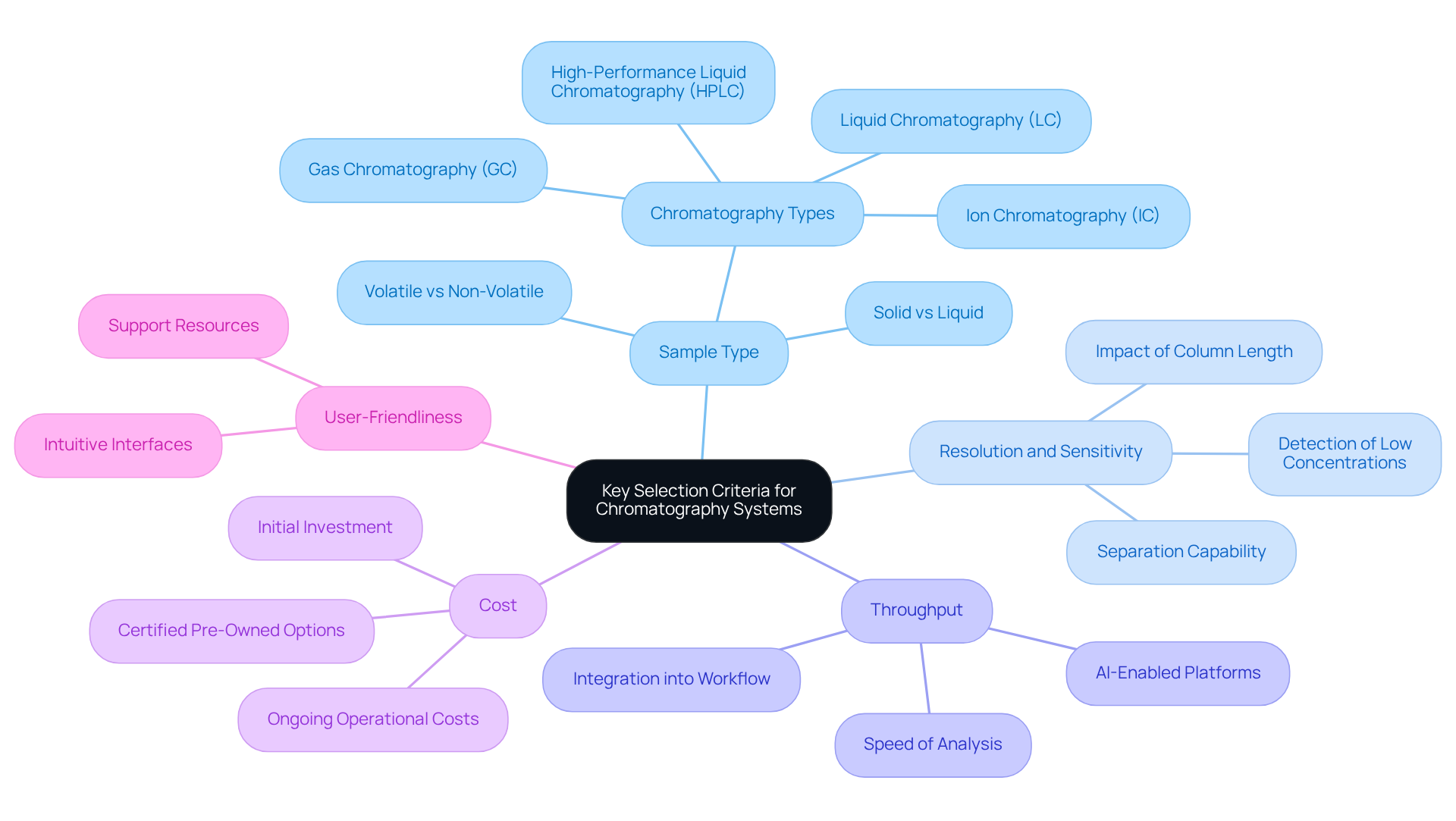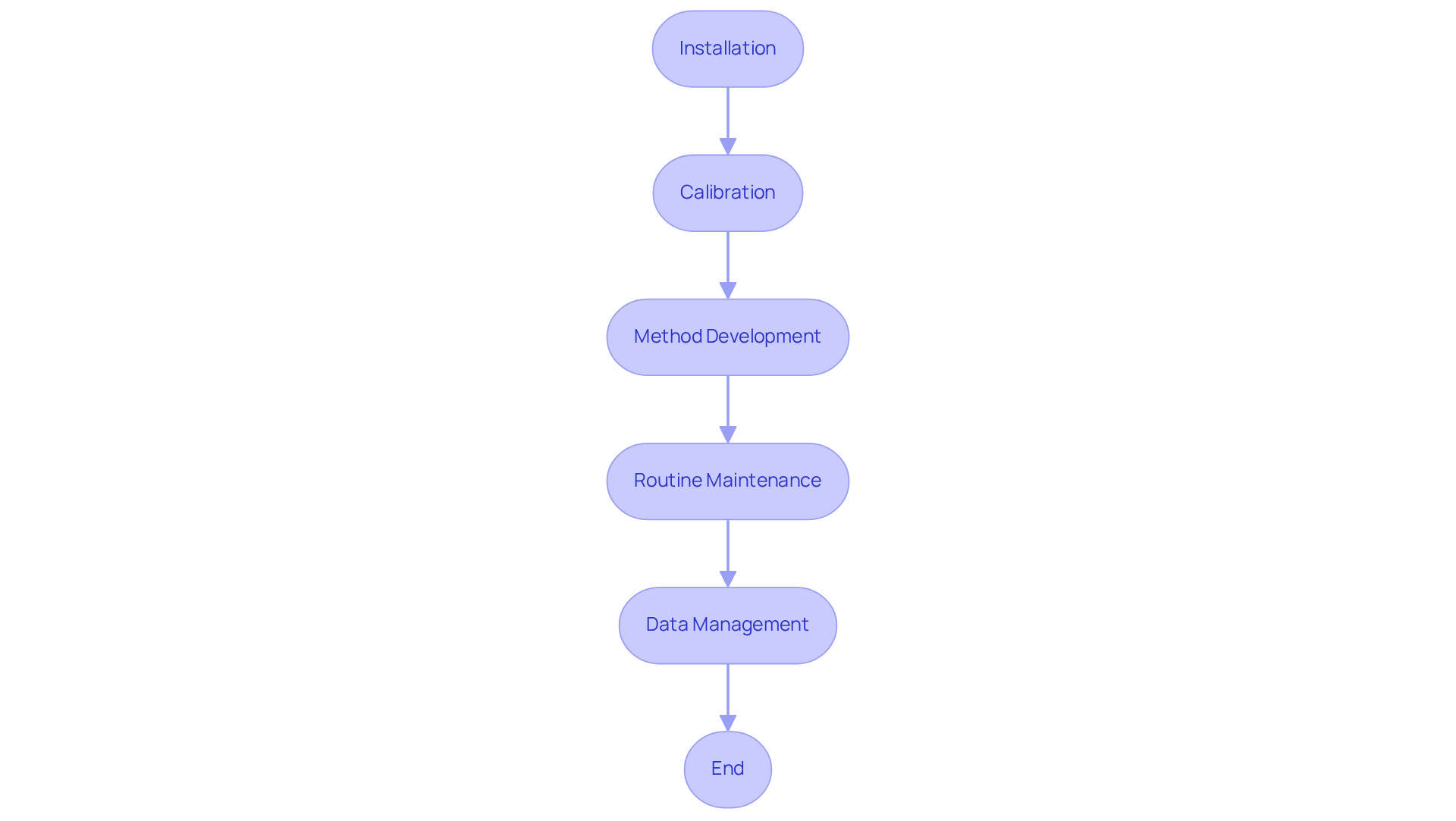Overview
Effective implementation of chromatography systems hinges on several key steps:
- Proper installation
- Regular calibration
- Method development
- Routine maintenance
- Efficient data management
These essential practices not only ensure optimal performance but also enhance the reliability of analytical results. Such reliability is crucial for meeting the diverse needs of laboratories, particularly in applications like pharmaceuticals and environmental testing. By adhering to these steps, laboratories can achieve excellence in their analytical endeavors, ultimately leading to superior outcomes in their respective fields.
Introduction
As laboratories increasingly adopt chromatography systems to elevate their analytical capabilities, grasping the intricacies of these techniques becomes paramount. This article explores the essential steps for the effective implementation of chromatography systems, providing insights into various types, selection criteria, and optimization strategies. With a plethora of options available, laboratory managers face the challenge of navigating the complexities of selecting the right system tailored to their specific needs while ensuring optimal performance. How can they make informed decisions in this intricate landscape?
Understand the Basics of Chromatography
Chromatography stands as a pivotal analytical method, adept at separating mixtures into their distinct components based on their movement through a stable medium, facilitated by a moving element. Understanding its fundamental principles is essential:
- Stationary Phase: This refers to the fixed material, either solid or liquid, that remains stationary throughout the chromatography process.
- Mobile Medium: This solvent traverses the stationary medium, carrying the sample along.
- Separation Mechanism: The components of the mixture are separated based on their affinity for the stationary phase relative to the mobile phase, leading to differing retention times.
As we look toward 2025, projections indicate that approximately 70% of laboratories will implement chromatography systems, highlighting the significance of these separation techniques in modern analytical practices. A robust understanding of these principles is vital for selecting the appropriate chromatography systems, thereby enhancing their efficacy across diverse applications, such as pharmaceutical development and environmental testing.
The real-world applications of stationary and mobile phases are particularly evident in drug formulation. The selection of these phases can profoundly influence the efficiency and precision of compound separation. For instance, in high-efficiency liquid separation, an appropriate choice of stationary medium can significantly enhance the resolution of complex mixtures, ensuring that pharmaceutical products meet stringent quality standards. Thus, grasping the interplay between stationary and mobile phases is crucial for laboratory managers aiming to implement for separation techniques.

Explore Different Types of Chromatography Systems
Understanding the distinct characteristics of chromatography systems, which come in various types tailored for specific applications, is essential.
High-Performance Liquid Chromatography (HPLC) stands out as an ideal choice for separating and analyzing compounds in liquid samples. This method is widely utilized in pharmaceuticals and environmental testing, showcasing its versatility and reliability.
Gas Chromatography (GC) excels in analyzing volatile compounds, making it the preferred technique in petrochemical and forensic analysis. Its effectiveness in these fields underscores the importance of selecting the right system for your laboratory's needs.
Thin-Layer Chromatography (TLC) offers a simple and cost-effective solution for qualitative analysis, often employed in educational settings. This method provides an accessible introduction to chromatographic techniques.
Ion Exchange Chromatography is particularly valuable for separating charged molecules, playing a crucial role in biochemistry and protein purification. Understanding these methodologies is vital for .
In conclusion, each chromatography system presents unique advantages, highlighting the necessity of comprehending their variations. This knowledge enables you to select the appropriate option that aligns with your laboratory's requirements.

Evaluate Key Selection Criteria for Chromatography Systems
When evaluating chromatography systems, it is essential to consider several key criteria to ensure their optimal performance and alignment with laboratory needs.
- Sample Type: Begin by identifying the characteristics of the samples to be analyzed, such as whether they are volatile, non-volatile, solid, or liquid. —gas chromatography (GC), liquid chromatography (LC), high-performance liquid chromatography (HPLC), and ion chromatography (IC)—each have unique applications and requirements. This determination is crucial, as it influences the choice of chromatography systems and column type.
- Resolution and Sensitivity: Next, evaluate the system's capability to effectively separate compounds and detect low concentrations. Higher resolution in chromatography systems is often achieved through longer columns; however, this may increase run times and solvent usage, necessitating a balance between performance and efficiency. As noted by Nicholas H. Snow, resolution in separation techniques is influenced by retention, engineering, and selectivity.
- Throughput: Assess the speed of analysis and its integration into your laboratory's workflow. Sophisticated frameworks can significantly decrease analytical turnaround durations, with AI-enabled platforms shortening cycle times by as much as 40%. The instrumentation market for chromatography systems and other separation techniques is projected to expand from USD 10.13 billion in 2025 to USD 13.08 billion by 2030, highlighting the rising demand for effective solutions.
- Cost: Analyze both the initial investment and ongoing operational costs, including maintenance and consumables. Basic separation techniques can start at approximately $10,000, while advanced configurations might exceed $500,000. Additionally, certified pre-owned programs offer entry points as low as $14,000, providing a broader perspective on cost options available to laboratories.
- User-Friendliness: Finally, opt for platforms that feature intuitive interfaces and robust support resources. For instance, JM Science offers how-to videos and application libraries to aid in training and operation.
By thoughtfully evaluating these factors, you can select chromatography systems as a separation technique that not only fulfills your laboratory's specific requirements but also enhances overall analytical capabilities.

Implement and Optimize Your Chromatography System
To effectively implement and optimize your chromatography system, it is imperative to adhere to the following key steps:
- Installation: Ensure the system is set up according to the manufacturer's guidelines, with proper connections for the mobile phase and detector to facilitate optimal operation.
- Calibration: Regular calibration is vital for maintaining measurement accuracy and precision. Research indicates that calibration frequency can significantly impact analytical variability; for example, optimal calibration intervals for certain phosphate species are recommended weekly for tripolyphosphate and every 10 weeks for ortho- and pyrophosphate. This practice guarantees and reliability in outcomes. As noted by Chun Yee Lim, 'Within the parameters of the simulation study, an increased frequency of calibration events does not negatively affect the overall analytical capability of a measurement procedure under most circumstances.'
- Method Development: Customize and validate methods specific to your applications, considering factors such as solvent composition and flow rates. This tailored approach is essential for achieving the desired analytical outcomes.
- Routine Maintenance: Establish a comprehensive maintenance timetable that includes cleaning, replacing consumables, and conducting efficiency checks. Routine upkeep prevents interruptions and ensures the longevity of the setup. Additionally, regular assessment of instrument functionality through control charting control samples is recommended to uphold optimal operation.
- Data Management: Implement data processing platforms (DPS) for efficient data acquisition, analysis, and reporting. Utilizing CDS not only streamlines operations but also ensures compliance with regulatory standards, which is crucial in pharmaceutical and clinical settings.
By following these steps, you can ensure that your chromatography systems operate at peak performance, delivering reliable results that meet your laboratory's analytical needs. Regular calibration and method optimization are not merely best practices; they are essential for advancing research and enhancing healthcare outcomes.

Conclusion
Mastering chromatography systems is imperative for laboratories seeking to elevate their analytical capabilities. The successful implementation of these systems relies on a comprehensive understanding of chromatography fundamentals, the careful selection of suitable types, and the assessment of key criteria tailored to specific laboratory needs.
This guide underscores the necessity of grasping the basic principles of chromatography while exploring various systems, including HPLC, GC, and TLC. Each system presents distinct advantages that cater to diverse applications, highlighting the critical importance of choosing the appropriate system for optimal results. Additionally, the evaluation criteria—spanning sample type, resolution, cost, and user-friendliness—offer a structured decision-making framework that aligns with laboratory objectives.
Ultimately, embarking on the journey toward effective chromatography system implementation demands a commitment to best practices, such as proper installation, regular calibration, and method development. By prioritizing these essential steps, laboratories can ensure their systems function efficiently and yield reliable results. Embracing these strategies not only enhances research outcomes but also strengthens the role of chromatography in propelling scientific advancement and improving healthcare solutions.




